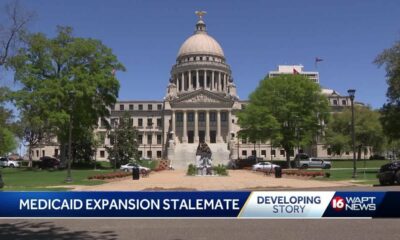Kaiser Health News
As Pandemic Emergencies End, People Battling Long Covid Feel ‘Swept Under the Rug’
by Jackie Fortiér, KPCC/LAist
Tue, 18 Apr 2023 09:00:00 +0000
Lost careers. Broken marriages. Dismissed and disbelieved by family and friends.
These are some of the emotional and financial struggles long covid patients face years after their infection. Physically, they are debilitated and in pain: unable to walk up the stairs, focus on a project, or hold down a job. Facing the end of the federal public health emergency in May, many people experiencing lingering effects of the virus say they feel angry and abandoned by policymakers eager to move on.
“Patients are losing hope,” said Shelby Hedgecock, a self-described long covid survivor from Knoxville, Tennessee, who now advocates for patients like herself. “We feel swept under the rug.”
The Centers for Disease Control and Prevention estimated in March that 6% of U.S. adults, or about 16 million, were experiencing long covid, or ongoing health problems that continue or emerge after a bout of covid-19. Researchers estimate that 1.6% of U.S. adults, or about 4 million, have symptoms that have significantly reduced their ability to carry out day-to-day activities.
While patients are no longer contagious, their health issues can stretch on and affect almost every system in the body. More than 200 symptoms and conditions, including fatigue and depression, are linked to long covid, said Linda Geng, a physician who treats patients at Stanford Medicine's Post-Acute COVID-19 Syndrome Clinic.
The severity and duration of long covid vary. Some people recover in a few weeks, while a smaller number have debilitating and lingering health issues. There is currently no test, treatment, or cure. There's not even an accepted medical definition.
“When you don't have any tests that show that anything's abnormal, it can be quite invalidating and anxiety-provoking,” Geng said.
The physical and emotional toll has left some feeling hopeless. A 2022 study of adults in Japan and Sweden found that those with post-covid conditions were more than twice as likely to develop mental health issues, including depression, anxiety, and post-traumatic stress, as people without them.
“One of my friends committed suicide in May of 2021,” Hedgecock said. “She had a mild covid infection, and she progressively had medical complications continuously pop up, and it just got so bad that she decided to end her life.”
In Los Angeles County, 46% of adults who contracted covid were fully recovered a month later, but the rest — a majority — reported one or more continuing symptoms, according to a 675-patient study by the University of Southern California's COVID-19 Pandemic Research Center. The researchers found chronic fatigue topped the list of health issues, followed by brain fog and persistent cough, all of which affect people's daily lives.
Among the respondents who identified as living with long covid, 77% said their condition limited daily activities such as going to school or work or socializing. One-quarter reported experiencing severe limitations.
Taking antivirals cuts the risk of developing long covid in people who are newly infected. But for people already suffering, medical science is trying to catch up.
Here's a look at Hedgecock and two other patients who have had long covid for years.
A Debilitating Brain Injury
Before contracting covid during spring 2020, Hedgecock's life revolved around fitness. She worked as a personal trainer in Los Angeles and competed in endurance competitions on the weekends. At 29, she was about to launch an online wellness business, then she started having trouble breathing.
“One of the scariest things that happened to me was I couldn't breathe at night,” Hedgecock said. “I did go to the emergency room on three different occasions, and each time I was told, ‘You're up and you're moving. You're young; you're healthy. It's going to be fine.'”
Her primary care physician at the time told her she didn't need supplemental oxygen even though her oxygen saturation dipped below normal at night, leaving her gasping for breath and crying in frustration.
Her condition kept her from one of her favorite hobbies, reading, for 19 months.
“I couldn't look at a page and tell you what it said. It was like there was a disconnect between the words and my brain,” she said. “It was the strangest, most discouraging thing ever.”
Months later, under the direction of a specialist, Hedgecock underwent a test measuring electrical activity in the brain. It revealed her brain had been starved of oxygen for months, damaging the section controlling memory and language.
Since then, she has moved back to Tennessee to be close to family. She doesn't leave her apartment without a medical alert button that can instantly call an ambulance. She works with a team of specialists, and she feels lucky; she knows people in online long covid groups who are losing health coverage as Medicaid pandemic protections expire, while others remain unable to work.
“A lot of them have lost their life savings. Some are experiencing homelessness,” she said.
In Bed for a Year
Julia Landis led a fulfilling life as a therapist before she contracted covid in spring 2020.
“I was really able to help people and it was great work and I loved my life, and I've lost it,” said the 56-year-old, who lives with her husband and dog in Ukiah, California.
In 2020, Landis was living in an apartment in Phoenix and received treatment via telehealth for her covid-related bronchitis. What started out as a mild case of covid spiraled into severe depression.
“I just stayed in bed for about a year,” she said.
Her depression has continued, along with debilitating pain and anxiety. To make up for her lost income, Landis' husband works longer hours, which in turn exacerbates her loneliness.
“It would be nice to be living somewhere where there were people around seven days a week so I wouldn't have to go through days of being just terrified to be alone all day,” Landis said. “If this were cancer, I'd be living with family. I'm sure of it.”
Landis refers to herself as a professional patient, filling her days with physical therapy and medical appointments. She's gradually improving and can socialize on occasion, though it leaves her exhausted and can take days to recover.
“It's terrifying because there's just no way of knowing if this is going to be for the rest of my existence,” she said.
‘I Felt Betrayed'
Linda Rosenthal, a 65-year-old retired high school paraprofessional, has long covid symptoms, including inflammation in her chest that makes breathing difficult. She has found it hard to get medical care.
She called and set up a treatment plan with a local cardiologist near her home in Orange County, California, but received a letter five days later telling her he would no longer be able to provide her medical services. The letter gave no reason for the cancellation.
“I was so surprised,” she said. “And then I felt betrayed because it is terrible to get a letter where a doctor, although within their rights, says that they don't want you for a patient anymore, because it causes self-doubt.”
Rosenthal found another cardiologist willing to do telehealth visits and who has staff wear masks in the office even though the state rule has expired. The practice, however, is more than an hour's drive from where she lives.
NEED HELP?
If you or someone you know is in a crisis, please call the National Suicide Prevention Lifeline at 1-800-273-TALK (8255) or contact the Crisis Text Line by texting HOME to 741741.
This article is part of a partnership that includes LAist, NPR, and KFF Health News.
This article was produced by KFF Health News, which publishes California Healthline, an editorially independent service of the California Health Care Foundation.
By: Jackie Fortiér, KPCC/LAist
Title: As Pandemic Emergencies End, People Battling Long Covid Feel ‘Swept Under the Rug'
Sourced From: kffhealthnews.org/news/article/long-covid-patients-end-of-pandemic-emergency/
Published Date: Tue, 18 Apr 2023 09:00:00 +0000
Kaiser Health News
Tire Toxicity Faces Fresh Scrutiny After Salmon Die-Offs
Jim Robbins
Wed, 24 Apr 2024 09:00:00 +0000
For decades, concerns about automobile pollution have focused on what comes out of the tailpipe. Now, researchers and regulators say, we need to pay more attention to toxic emissions from tires as vehicles roll down the road.
At the top of the list of worries is a chemical called 6PPD, which is added to rubber tires to help them last longer. When tires wear on pavement, 6PPD is released. It reacts with ozone to become a different chemical, 6PPD-q, which can be extremely toxic — so much so that it has been linked to repeated fish kills in Washington state.
The trouble with tires doesn't stop there. Tires are made primarily of natural rubber and synthetic rubber, but they contain hundreds of other ingredients, often including steel and heavy metals such as copper, lead, cadmium, and zinc.
As car tires wear, the rubber disappears in particles, both bits that can be seen with the naked eye and microparticles. Testing by a British company, Emissions Analytics, found that a car's tires emit 1 trillion ultrafine particles per kilometer driven — from 5 to 9 pounds of rubber per internal combustion car per year.
And what's in those particles is a mystery, because tire ingredients are proprietary.
“You've got a chemical cocktail in these tires that no one really understands and is kept highly confidential by the tire manufacturers,” said Nick Molden, CEO of Emissions Analytics. “We struggle to think of another consumer product that is so prevalent in the world and used by virtually everyone, where there is so little known of what is in them.”
Regulators have only begun to address the toxic tire problem, though there has been some action on 6PPD.
The chemical was identified by a team of researchers, led by scientists at Washington State University and the University of Washington, who were trying to determine why coho salmon returning to Seattle-area creeks to spawn were dying in large numbers.
Working for the Washington Stormwater Center, the scientists tested some 2,000 substances to determine which one was causing the die-offs, and in 2020 they announced they'd found the culprit: 6PPD.
The Yurok Tribe in Northern California, along with two other West Coast Native American tribes, have petitioned the Environmental Protection Agency to prohibit the chemical. The EPA said it is considering new rules governing the chemical. “We could not sit idle while 6PPD kills the fish that sustain us,” said Joseph L. James, chairman of the Yurok Tribe, in a statement. “This lethal toxin has no place in any salmon-bearing watershed.”
California has begun taking steps to regulate the chemical, last year classifying tires containing it as a “priority product,” which requires manufacturers to search for and test substitutes.
“6PPD plays a crucial role in the safety of tires on California's roads and, currently, there are no widely available safer alternatives,” said Karl Palmer, a deputy director at the state's Department of Toxic Substances Control. “For this reason, our framework is ideally suited for identifying alternatives to 6PPD that ensure the continued safety of tires on California's roads while protecting California's fish populations and the communities that rely on them.”
The U.S. Tire Manufacturers Association says it has mobilized a consortium of 16 tire manufacturers to carry out an analysis of alternatives. Anne Forristall Luke, USTMA president and CEO, said it “will yield the most effective and exhaustive review possible of whether a safer alternative to 6PPD in tires currently exists.”
Molden, however, said there is a catch. “If they don't investigate, they aren't allowed to sell in the state of California,” he said. “If they investigate and don't find an alternative, they can go on selling. They don't have to find a substitute. And today there is no alternative to 6PPD.”
California is also studying a request by the California Stormwater Quality Association to classify tires containing zinc, a heavy metal, as a priority product, requiring manufacturers to search for an alternative. Zinc is used in the vulcanization process to increase the strength of the rubber.
When it comes to tire particles, though, there hasn't been any action, even as the problem worsens with the proliferation of electric cars. Because of their quicker acceleration and greater torque, electric vehicles wear out tires faster and emit an estimated 20% more tire particles than the average gas-powered car.
A recent study in Southern California found tire and brake emissions in Anaheim accounted for 30% of PM2.5, a small-particulate air pollutant, while exhaust emissions accounted for 19%. Tests by Emissions Analytics have found that tires produce up to 2,000 times as much particle pollution by mass as tailpipes.
These particles end up in water and air and are often ingested. Ultrafine particles, even smaller than PM2.5, are also emitted by tires and can be inhaled and travel directly to the brain. New research suggests tire microparticles should be classified as a pollutant of “high concern.”
In a report issued last year, researchers at Imperial College London said the particles could affect the heart, lungs, and reproductive organs and cause cancer.
People who live or work along roadways, often low-income, are exposed to more of the toxic substances.
Tires are also a major source of microplastics. More than three-quarters of microplastics entering the ocean come from the synthetic rubber in tires, according to a report from the Pew Charitable Trusts and the British company Systemiq.
And there are still a great many unknowns in tire emissions, which can be especially complex to analyze because heat and pressure can transform tire ingredients into other compounds.
One outstanding research question is whether 6PPD-q affects people, and what health problems, if any, it could cause. A recent study published in Environmental Science & Technology Letters found high levels of the chemical in urine samples from a region of South China, with levels highest in pregnant women.
The discovery of 6PPD-q, Molden said, has sparked fresh interest in the health and environmental impacts of tires, and he expects an abundance of new research in the coming years. “The jigsaw pieces are coming together,” he said. “But it's a thousand-piece jigsaw, not a 200-piece jigsaw.”
This article was produced by KFF Health News, which publishes California Healthline, an editorially independent service of the California Health Care Foundation.
KFF Health News is a national newsroom that produces in-depth journalism about health issues and is one of the core operating programs at KFF—an independent source of health policy research, polling, and journalism. Learn more about KFF.
USE OUR CONTENT
This story can be republished for free (details).
——————————
By: Jim Robbins
Title: Tire Toxicity Faces Fresh Scrutiny After Salmon Die-Offs
Sourced From: kffhealthnews.org/news/article/tire-toxicity-salmon-die-offs-research-6ppd/
Published Date: Wed, 24 Apr 2024 09:00:00 +0000
Did you miss our previous article…
https://www.biloxinewsevents.com/ftc-chief-says-tech-advancements-risk-health-care-price-fixing/
Kaiser Health News
FTC Chief Says Tech Advancements Risk Health Care Price Fixing
Julie Rovner, KFF Health News and David Hilzenrath
Tue, 23 Apr 2024 13:13:59 +0000
New technologies are making it easier for companies to fix prices and discriminate against individual consumers, the Biden administration's top consumer watchdog said Tuesday.
Algorithms make it possible for companies to fix prices without explicitly coordinating with one another, posing a new test for regulators policing the market, said Lina Khan, chair of the Federal Trade Commission, during a media event hosted by KFF.
“I think we could be entering a somewhat novel era of pricing,” Khan told reporters.
Khan is regarded as one of the most aggressive antitrust regulators in recent U.S. history, and she has paid particular attention to the harm that technological advances can pose to consumers. Antitrust regulators at the FTC and the Justice Department set a record for merger challenges in the fiscal year that ended Sept. 30, 2022, according to Bloomberg News.
Last year, the FTC successfully blocked biotech company Illumina's over $7 billion acquisition of cancer-screening company Grail. The FTC, Justice Department, and Health and Human Services Department launched a website on April 18, healthycompetition.gov, to make it easier for people to report suspected anticompetitive behavior in the health care industry.
The American Hospital Association, the industry's largest trade group, has often criticized the Biden administration's approach to antitrust enforcement. In comments in September on proposed guidance the FTC and Justice Department published for companies, the AHA said that “the guidelines reflect a fundamental hostility to mergers.”
Price fixing removes competition from the market and generally makes goods and services more expensive. The agency has argued in court filings that price fixing “is still illegal even if you are achieving it through an algorithm,” Khan said. “There's no kind of algorithmic exemption to the antitrust laws.”
By simply using the same algorithms to set prices, companies can effectively charge the same “even if they're not, you know, getting in a back room and kind of shaking hands and setting a price,” Khan said, using the example of residential property managers.
Khan said the commission is also scrutinizing the use of artificial intelligence and algorithms to set prices for individual consumers “based on all of this particular behavioral data about you: the websites you visited, you know, who you had lunch with, where you live.”
And as health care companies change the way they structure their businesses to maximize profits, the FTC is changing the way it analyzes behavior that could hurt consumers, Khan said.
Hiring people who can “help us look under the hood” of some inscrutable algorithms was a priority, Khan said. She said it's already paid off in the form of legal actions “that are only possible because we had technologists on the team helping us figure out what are these algorithms doing.”
Traditionally, the FTC has policed health care by challenging local or regional hospital mergers that have the potential to reduce competition and raise prices. But consolidation in health care has evolved, Khan said.
Mergers of systems that don't overlap geographically are increasing, she said. In addition, hospitals now often buy doctor practices, while pharmacy benefit managers start their own insurance companies or mail-order pharmacies — or vice versa — pursuing “vertical integration” that can hurt consumers, she said.
The FTC is hearing increasing complaints “about how these firms are using their monopoly power” and “exercising it in ways that's resulting in higher prices for patients, less service, as well as worse conditions for health care workers,” Khan said.
Policing Noncompetes
Khan said she was surprised at how many health care workers responded to the commission's recent proposal to ban “noncompete” clauses — agreements that can prevent employees from moving to new jobs. The FTC issued its final rule banning the practice on Tuesday. She said the ban was aimed at low-wage industries like fast food but that many of the comments in favor of the FTC's plan came from health professions.
Health workers say noncompete agreements are “both personally devastating and also impeded patient care,” Khan said.
In some cases, doctors wrote that their patients “got really upset because they wanted to stick with me, but my hospital was saying I couldn't,” Khan said. Some doctors ended up commuting long distances to prevent the rest of their families from having to move after they changed jobs, she said.
KFF Health News is a national newsroom that produces in-depth journalism about health issues and is one of the core operating programs at KFF—an independent source of health policy research, polling, and journalism. Learn more about KFF.
USE OUR CONTENT
This story can be republished for free (details).
——————————
By: Julie Rovner, KFF Health News and David Hilzenrath
Title: FTC Chief Says Tech Advancements Risk Health Care Price Fixing
Sourced From: kffhealthnews.org/news/article/ftc-lina-khan-price-fixing-noncompete-mergers/
Published Date: Tue, 23 Apr 2024 13:13:59 +0000
Did you miss our previous article…
https://www.biloxinewsevents.com/unsheltered-people-are-losing-medicaid-in-redetermination-mix-ups/
Kaiser Health News
Unsheltered People Are Losing Medicaid in Redetermination Mix-Ups
Aaron Bolton, MTPR
Tue, 23 Apr 2024 09:00:00 +0000
KALISPELL, Mont. — On a cold February morning at the Flathead Warming Center, Tashya Evans waited for help with her Medicaid application as others at the shelter got ready for the day in this northwestern Montana city.
Evans said she lost Medicaid coverage in September because she hadn't received paperwork after moving from Great Falls, Montana. She has had to forgo the blood pressure medication she can no longer pay for since losing coverage. She has also had to put off needed dental work.
“The teeth broke off. My gums hurt. There's some times where I'm not feeling good, I don't want to eat,” she said.
Evans is one of about 130,000 Montanans who have lost Medicaid coverage as the state reevaluates everyone's eligibility following a pause in disenrollments during the covid-19 pandemic. About two-thirds of those who were kicked off state Medicaid rolls lost coverage for technical reasons, such as incorrectly filling out paperwork. That's one of the highest procedural disenrollment rates in the nation, according to a KFF analysis.
Even unsheltered people like Evans are losing their coverage, despite state officials saying they would automatically renew people who should still qualify by using Social Security and disability data.
As other guests filtered out of the shelter that February morning, Evans sat down in a spare office with an application counselor from Greater Valley Health Clinic, which serves much of the homeless population here, and recounted her struggle to reenroll.
She said that she had asked for help at the state public assistance office, but that the staff didn't have time to answer her questions about which forms she needed to fill out or to walk her through the paperwork. She tried the state's help line, but couldn't get through.
“You just get to the point where you're like, ‘I'm frustrated right now. I just have other things that are more important, and let's not deal with it,'” she said.
Evans has a job and spends her free time finding a place to sleep since she doesn't have housing. Waiting on the phone most of the day isn't feasible.
There's no public data on how many unhoused people in Montana or nationwide have lost Medicaid, but homeless service providers and experts say it's a big problem.
Those assisting unsheltered people who have lost coverage say they spend much of their time helping people contact the Montana Medicaid office. Sorting through paperwork mistakes is also a headache, said Crystal Baker, a case manager at HRDC, a homeless shelter in Bozeman.
“We're getting mail that's like, ‘Oh, this needs to be turned in by this date,' and that's already two weeks past. So, now we have to start the process all over again,” she said. “Now, they have to wait two to three months without insurance.”
Montana health officials told NPR and KFF Health News in a statement that they provided training to help homeless service agencies prepare their clients for redetermination.
Federal health officials have warned Montana and some other conservative states against disenrolling high rates of people for technicalities, also known as procedural disenrollment. They also warned states about unreasonable barriers to accessing help, such as long hold times on help lines. The Centers for Medicare & Medicaid Services said if states don't reduce the rate of procedural disenrollments, the agency could force them to halt their redetermination process altogether. So far, CMS hasn't taken that step.
Charlie Brereton, the director of the Montana health department, resisted calls from Democratic state lawmakers to pause the redetermination process. Redetermination ended in January, four months ahead of the federal deadline.
“I'm confident in our redetermination process,” Brereton told lawmakers in December. “I do believe that many of the Medicaid members who've been disenrolled were disenrolled correctly.
Health industry observers say that both liberal-leaning and conservative-leaning states are kicking homeless people off their rolls and that the redetermination process has been chaotic everywhere. Because of the barriers that unsheltered people face, it's easy for them to fall through the cracks.
Margot Kushel, a physician and a homeless researcher at the University of California-San Francisco, said it may not seem like a big deal to fill out paperwork. But, she said, “put yourself in the position of an elder experiencing homelessness,” especially those without access to a computer, phone, or car.
If they still qualify, people can usually get their Medicaid coverage renewed — eventually — and it may reimburse patients retroactively for care received while they were unenrolled.
Kushel said being without Medicaid for any period can be particularly dangerous for people who are homeless. This population tends to have high rates of chronic health conditions.
“Being out of your asthma medicine for three days can be life-threatening. If you have high blood pressure and you suddenly stop your medicine, your blood pressure shoots up, and your risk of having a heart attack goes way up,” she said.
When people don't understand why they're losing coverage or how to get it back, that erodes their trust in the medical system, Kushel said.
Evans, the homeless woman, was able to get help with her application and is likely to regain coverage.
Agencies that serve unhoused people said it could take years to get everyone who lost coverage back on Medicaid. They worry that those who go without coverage will resort to using the emergency room rather than managing their health conditions proactively.
Baker, the case manager at the Bozeman shelter, set up several callbacks from the state Medicaid office for one client. The state needed to interview him to make sure he still qualified, but the state never called.
“He waited all day long. By the fifth time, it was so stressful for him, he just gave up,” she said.
That client ended up leaving the Bozeman area before Baker could convince him it was worth trying to regain Medicaid.
Baker worries his poor health will catch up with him before he decides to try again.
This article is from a partnership that includes MTPR, NPR, and KFF Health News.
——————————
By: Aaron Bolton, MTPR
Title: Unsheltered People Are Losing Medicaid in Redetermination Mix-Ups
Sourced From: kffhealthnews.org/news/article/unsheltered-people-losing-medicaid-redetermination-paperwork/
Published Date: Tue, 23 Apr 2024 09:00:00 +0000
-
SuperTalk FM7 days ago
2 arrested after missing man’s body found on side of Mississippi highway
-
Mississippi News6 days ago
What this means for local schools
-
228Sports4 days ago
From Heartbreak to Hoop Dreams: Pascagoula Panthers Springboard from Semifinal Setback to College Courts
-
Mississippi News3 days ago
2 dead, 6 hurt in shooting at Memphis, Tennessee block party: police
-
Mississippi News6 days ago
Willis Miller sentenced to 45 years in prison, mandatory
-
Mississippi News3 days ago
Forest landowners can apply for federal emergency loans
-
Mississippi Today6 days ago
The unlikely Mississippi politician who could tank Medicaid expansion
-
Mississippi News2 days ago
Cicadas expected to takeover north Mississippi counties soon


































